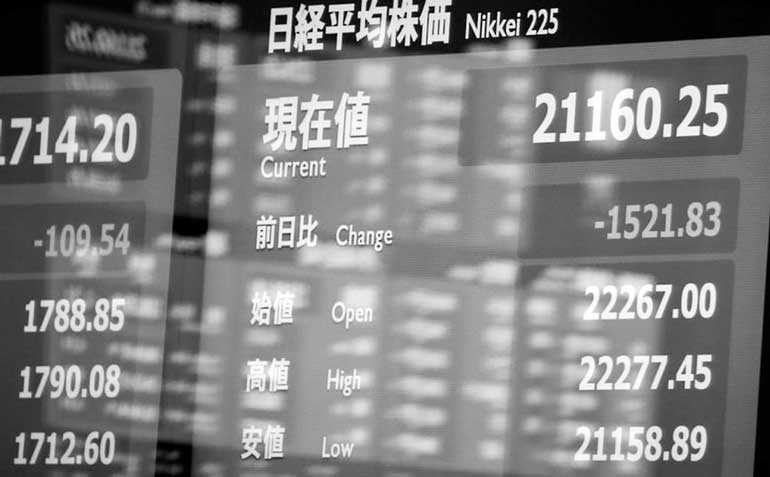Monday Mar 10, 2025
Monday Mar 10, 2025
Saturday, 6 October 2018 00:10 - - {{hitsCtrl.values.hits}}

TOKYO (Reuters): Asian shares wobbled on Friday after benchmark US Treasury yields surged to a fresh seven-year high and strong economic data fanned concerns about the risk of faster-than-expected interest rate rises.
MSCI’s broadest index of Asia-Pacific shares outside Japan fell 0.6%, while Japan’s Nikkei average closed down 0.8% and Hong Kong’s Hang Seng slipped 0.1%.
“Rapidly rising Treasury yields are rocking equity markets around the globe, with high price-to-earnings tech stocks leading the decline,” said Yasuo Sakuma, Chief Investment Officer at Libra Investments.
While most Asian shares are seen ending their session in the red, financial spreadbetters expect London’s FTSE to open 21 points higher, Frankfurt’s DAX to rise 3 points and Paris’s CAC to add 2 points.
The yield on the benchmark 10-year note hit a fresh seven-year high of 3.232% overnight after figures out earlier were seen as increasing the odds Friday’s payrolls report would also be stronger than expected.
Wall Street stocks fell broadly on Thursday, with the Dow suffering its first decline in six sessions and both the S&P 500 and Nasdaq seeing their worst day since 25 June.
The Dow Jones Industrial Average fell 0.8%, while the S&P 500 lost 0.8% and the Nasdaq Composite dropped 1.8%.
The CBOE Global Markets volatility index, known as Wall Street’s “fear gauge”, jumped as high as 15.84, its highest since 15 August.
The Japanese equivalent of VIX also rose, with the Nikkei volatility index surging as high as 19.07, its highest in seven weeks.
Fed Chairman Jerome Powell said earlier this week the economy can expand for “quite some time,” which also helped the yield curve steepen to its highest in two months.
Jeffrey Gundlach, chief executive of Doubleline Capital, told Reuters on Thursday that the 30-year US Treasury bond yield has broken above a multi-year base, which should lead to significantly higher in financial markets.
“As I have been saying, two consecutive closes above 3.25% on the benchmark 30-year Treasury means that my statement in July 2016 that we were seeing the low - I said italicized, underlined and in boldface – is now, looking at the charts, thoroughly corroborated,” he said.
On Thursday, the 30-year Treasury note closed at 3.35%, compared with 3.34% on Wednesday.
The surge in Treasury yields has also prompted a rise in government bond yields across the globe, with a major exception being Italy, where borrowing costs dropped after the government said it would cut budget deficit targets from 2020.
Japanese government bond yields eased slightly after hitting 2-1/2-year highs on Thursday, the highest levels since the Bank of Japan introduced negative rates in early 2016.
The spread between junk bonds and long-end US Treasuries shrank to the narrowest since 2007 on Wednesday as government debt was sold off heavily, with analysts closely watching to see if that could signal an imminent end to the credit cycle.
The premium investors are paid, or the average spread, of US corporate “junk” bond yields over Treasury debt, fell to 3.16 percentage points on Wednesday, the tightest since just before the financial crisis, according to the ICE BofAML US High Yield Master II Option-Adjusted Spread
The US dollar was steady but lingered near recent highs against the euro and the yen as investors assessed US economic data and Powell’s remarks.
The dollar index was little changed at 95.787, with the euro softening 0.1% to $1.1509. The Japanese yen was flat versus the greenback at 113.93 per dollar.
Investors are expected to scour the US Government’s September payroll report scheduled for release on Friday and look closely for signs of wage growth, especially in light of anecdotal indications of rising wages.
“Although we are likely to see strong payroll figures later today, we could see some corrections in markets ahead of a long weekend in the United States and Japan,” said Naoki Iwami, Fixed Income Chief Investment Officer at Whiz Partners.
Oil prices rose on Friday, two days after hitting four-year highs, as traders anticipated a tighter market due to US sanctions against Iran’s crude exports, which are set to start next month.
US crude oil futures rose 0.7% to $74.88 barrel and Brent crude futures gained 0.5% to $85.03 barrel.
Gold prices were steady on Friday as investors remained cautious after US Treasury yields hit multi-year peaks. Gold gained 0.6% for the week, and was on track to mark its biggest weekly gain in six.
Discover Kapruka, the leading online shopping platform in Sri Lanka, where you can conveniently send Gifts and Flowers to your loved ones for any event including Valentine ’s Day. Explore a wide range of popular Shopping Categories on Kapruka, including Toys, Groceries, Electronics, Birthday Cakes, Fruits, Chocolates, Flower Bouquets, Clothing, Watches, Lingerie, Gift Sets and Jewellery. Also if you’re interested in selling with Kapruka, Partner Central by Kapruka is the best solution to start with. Moreover, through Kapruka Global Shop, you can also enjoy the convenience of purchasing products from renowned platforms like Amazon and eBay and have them delivered to Sri Lanka.
Discover Kapruka, the leading online shopping platform in Sri Lanka, where you can conveniently send Gifts and Flowers to your loved ones for any event including Valentine ’s Day. Explore a wide range of popular Shopping Categories on Kapruka, including Toys, Groceries, Electronics, Birthday Cakes, Fruits, Chocolates, Flower Bouquets, Clothing, Watches, Lingerie, Gift Sets and Jewellery. Also if you’re interested in selling with Kapruka, Partner Central by Kapruka is the best solution to start with. Moreover, through Kapruka Global Shop, you can also enjoy the convenience of purchasing products from renowned platforms like Amazon and eBay and have them delivered to Sri Lanka.